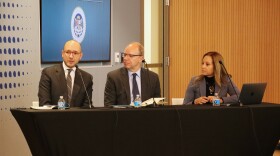


Fifty miles north of Baghdad sprawls the largest U.S. military supply center in Iraq. It's called Anaconda, and from here the things that keep an army going flow out to much of Iraq.
But those supplies must come to Anaconda by truck — all the way up from Kuwait on a road the Army calls Tampa, or Highway 1. It's the job of the 875th Engineering Battalion of the Arkansas National Guard to keep a long section of this road clear of insurgents and their roadside bombs, so the big convoys can get through safely. But the 875th's section of the road is increasingly coming under attack.
One recent morning, the sun is just coming up at Anaconda as soldiers climb up on their armored vehicles and carefully washed the windows with Windex. Sharp eyes and clean windows are critical to this mission. Lt. Paul Burns gathers the men of Alpha Company for the morning briefing. He tells them of an attack that occurred the day before on the route we will be on.
"Right after they got off, turned south on Tampa, they got hit," Burns says. "Once again, it's normally fairly quiet, but it's been busier lately. So the long and the short of it is, we've seen a lot. We need to be on our toes today."
The attack he mentions involved an improvised explosive device, small-arms fire, and a rocket-propelled grenade. Over the past three weeks, this area has been heating up.
Three soldiers and this reporter climb a ladder into a Buffalo, a monstrous Mac truck slabbed with half-inch armor. High off the ground, with a V-shaped belly to deflect blasts, it also boasts a long mechanical arm to grapple with explosives.
We roll off the base with an escort of RG31s — essentially gunboats on wheels bristling with 50 caliber machine guns. Sgt. Michael Smithson, a fireman at home, is the commander of the Buffalo. He's from northeast Arkansas, like most of this battalion called the Flying Razorbacks. Smithson has had five IEDs explode near his thick-hided Buffalo.
"When it hits," Smithson says, "It's this loud, rough... you get such an adrenaline spike, then after that you get kind of pissed off that you didn't find it and that they blew it on you."
The potential deadliness of the area stands in stark contrast to the pastoral landscape: fields of soft tufted reeds sway in the breeze; small boys herd flocks of goats; women in black and scarlet robes shoulder bundles of firewood.
Not long after we swing onto the divided four-lane highway, one of the armored escort vehicles radios the Buffalo about a downed power line at the roadside. It's been noticed that just around the wire leading down into it, the earth is dry, while everything around it is wet mud.
It's just a small patch, and only trained eyes could have noticed it. But it's a false alarm. The wire is hot and has parched the soil. The convoy grinds on down the highway at just 10 miles an hour, blocking both sides. Turret gunners wave cars aside. Some lone cars are carefully watched.
Traffic piles up, and as we drive by, a few passengers wave. But most just stare impassively. On this stretch, the roadside and the muddy median strip are regularly punctuated by blast holes — reminders of the daily IED attacks designed to disrupt the supply convoys. Sgt. Smithson stops at one of the holes and manipulates his long hydraulic arm.
"Whenever you see something different in a blast hole," Smithson says, "we'll use the arm there, dig around a little bit, see if there's anything in there."
There's nothing in this one, but I ask why insurgents would keep returning to the same hole over and over again.
"Since it's all loose and everything," Smithson answers, "they can go ahead and place another IED in there quick, [and] hopefully not get caught."
It's not long before we come to a trench that has been ripped across all four lanes of the highway. A Stryker armored vehicle was hit there, with an estimated 2,000-3,000 pounds of explosives.
Miraculously no one in the armored vehicle was seriously injured. But the road is still so damaged that even after repairs, a large convoy truck would have to crawl over it at 2 or 3 miles an hour — perfect for an ambush. We stop as a radio command comes in.
"Looks like we have a command wire about 5 meters off the road," the speaker says, "and the sun is reflecting off it."
A command wire is a hair-thin, bare copper strand that only the sharpest eye can see. Insurgents use them in pairs to trigger an IED when they are not using a wireless device like a cell phone. So there may be another IED here.
Driver Stephen Moore swings the Buffalo across the median where the wire was spotted. He and Smithson scan the area with binoculars. Moore spots it, a wire that goes into a bag but doesn't come back out, where the grass meets the dirt.
Moore maneuvers in close to where the wires lead and Smithson begins to work the Buffalo's manipulating arm. Then he turns to me, and asks if I have earplugs.
The blast earplugs help protect your eardrums. Medic Michael Rainey and I put on fire-resistant gloves. Sgt. Smithson stares intently at an image sent from a camera out on the arm, as he deftly pulls the wires away from the mud. Then he begins the tricky part: digging. A few minutes later he mutters, "Got it."
"There's a IED right here. Just got it dug up. We're gonna finish interrogating it a little bit here."
Sitting on Smithson's fork is an ugly, dirt-covered, two-foot-long mortar round, which he teases for a while, cleaning the mud off it. Then he gently rolls it off and marks it with a plastic bottle. We back off a couple of hundred yards and an explosive expert detonates the round. Hardly a sound penetrates the thick-skinned Buffalo, but a big, black mushroom of smoke billows up.
Back at the base, Lt. Burns, a man of few words, compliments the company on the find.
"It's always a good day when we find them without having someone blow them after we find them," Burns says, "which happens quite a bit. So we found it and we cleared it."
But still, it's not easy for the 411th Engineering Brigade, the Flying Razorbacks' mother organization, to keep up with repairs on this vital supply artery as attacks increase.
And the soldiers of the 875th worry that the renewed pressure on Baghdad may push more insurgents their way, bringing with them high-tech bombs that can penetrate even the thickest armor.
Copyright 2022 NPR. To see more, visit https://www.npr.org. 9(MDAzMjM2NDYzMDEyMzc1Njk5NjAxNzY3OQ001))







